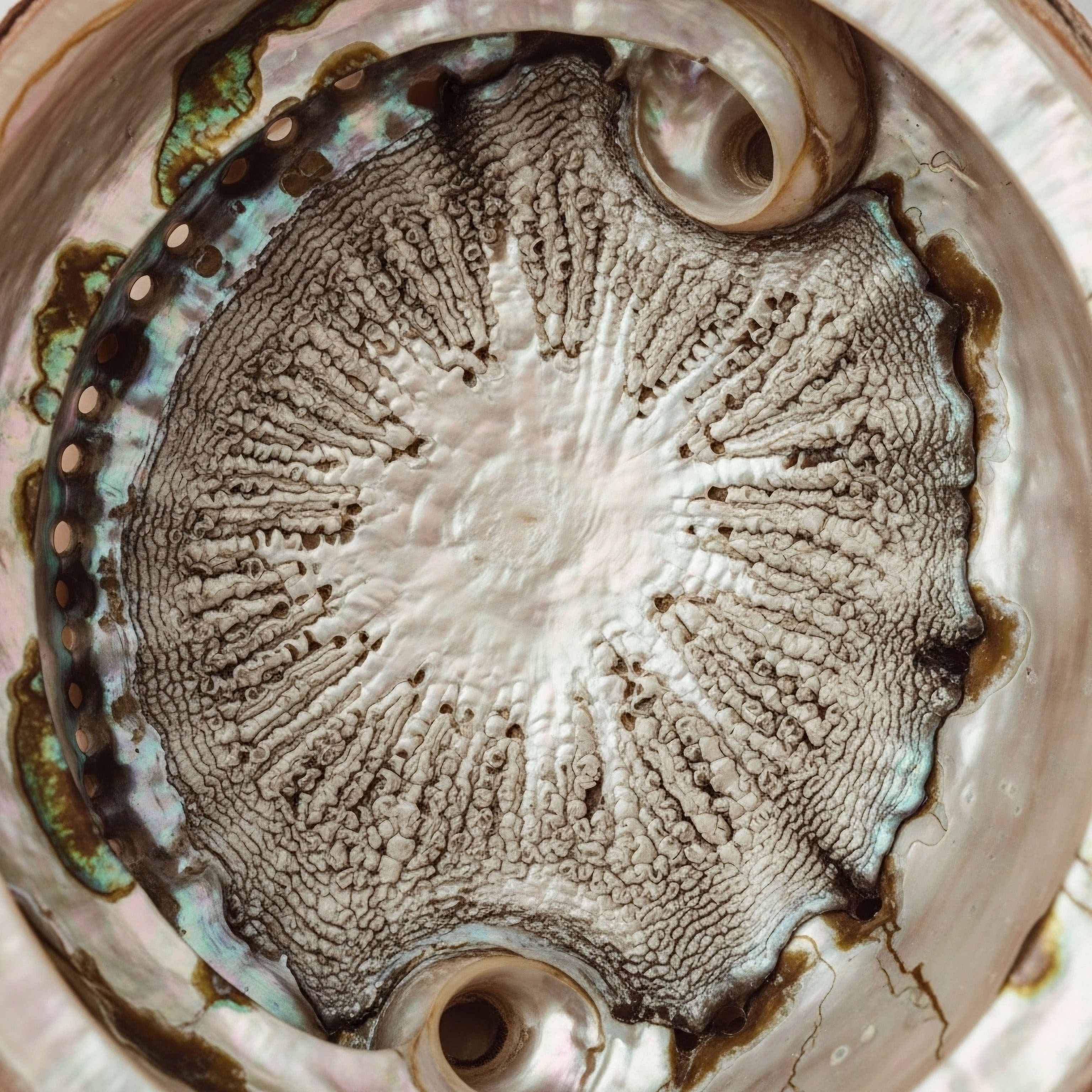

Fundamentals
Waking in the middle of the night, sheets damp and clinging, is a deeply personal and unsettling experience. It disrupts the restorative peace of sleep and can leave you feeling exhausted and anxious about what your body is trying to communicate. This experience of nocturnal sweating is a powerful signal from your internal environment.
The biological systems governing your body are sending a message that a state of imbalance exists. Understanding this message begins with looking at the adrenal glands, two small but powerful organs that sit atop your kidneys.
These glands are central to your body’s stress response system. They produce hormones that are fundamental to survival, orchestrating how you react to every challenge, from an immediate physical threat to the persistent pressure of a demanding schedule. The conversation about night sweats often centers on menopause, yet the adrenal system’s influence provides a much broader and more complete picture, relevant to both men and women at various stages of life.

The Adrenal Glands and Their Hormonal Messengers
Your adrenal glands are sophisticated hormonal production facilities. They are composed of two distinct parts ∞ the inner medulla and the outer cortex. Each part produces a different class of hormones that regulate a vast array of bodily functions.
The adrenal cortex produces steroid hormones, the most well-known of which is cortisol. Cortisol is often called the “stress hormone,” a term that only captures a fraction of its role. It influences metabolism by helping control the use of fats, proteins, and carbohydrates.
It also helps regulate blood pressure, manage inflammation, and critically, it governs the sleep-wake cycle. The adrenal cortex also produces aldosterone, which manages salt and water balance, and a small amount of sex hormones like testosterone.
The adrenal medulla produces catecholamines, primarily epinephrine (adrenaline) and norepinephrine (noradrenaline). These are the “fight-or-flight” hormones, responsible for the rapid, short-term responses needed in an emergency. They increase heart rate, shuttle blood flow to the muscles and brain, and boost blood sugar for a quick energy surge. While their action is fast, their effects can ripple through your system, influencing everything from your mood to your body temperature.

Cortisol’s Rhythm and Body Temperature
Your body operates on a finely tuned internal clock known as the circadian rhythm. This 24-hour cycle dictates nearly every biological process, including your sleep patterns and body temperature. Cortisol secretion is a cornerstone of this rhythm. In a balanced system, cortisol levels are highest in the morning, about 30 minutes after you wake up.
This morning surge provides the energy and alertness needed to start the day. Throughout the day, cortisol levels gradually decline, reaching their lowest point around midnight, which allows your body to relax into deep, restorative sleep.
This rhythm is directly linked to your body’s thermoregulation. Your core body temperature also follows a circadian pattern, naturally decreasing in the hours before sleep. This drop in temperature is a critical signal for sleep onset. The relationship is elegant ∞ as the stimulating influence of cortisol wanes in the evening, your body temperature falls, paving the way for sleep.
When this delicate hormonal rhythm is disrupted, so is your ability to regulate temperature during the night. An untimely surge of cortisol or catecholamines at night can override the body’s natural cooling process, triggering the heat-dissipation response we experience as a hot flash or night sweat.
Your body’s internal clock dictates a daily rise and fall of cortisol, a rhythm that is essential for both restful sleep and stable body temperature.
This perspective reframes nocturnal sweating. It is a symptom, but it is also a data point. It indicates a dysregulation in the precise, rhythmic release of adrenal hormones that are supposed to keep you calm and cool during the night. Understanding this connection is the first step in identifying the root causes of the disruption and reclaiming the ability to sleep soundly through the night.


Intermediate
The occasional night sweat might be dismissed, but when it becomes a recurring disruption, it points toward a deeper systemic imbalance. The fundamental link between adrenal hormones and nocturnal sweating is clear, but the mechanism behind this connection is governed by a complex communication network known as the Hypothalamic-Pituitary-Adrenal (HPA) axis.
This axis is the command center for your body’s stress response, and its function or dysfunction is central to understanding why you might be waking up in a sweat.

Decoding the HPA Axis
The HPA axis is a three-way conversation between different parts of your brain and your adrenal glands. It is a classic endocrine feedback loop, designed to self-regulate and maintain a state of balance, or homeostasis.
- The Hypothalamus ∞ When your brain perceives a stressor ∞ be it physical, emotional, or psychological ∞ the hypothalamus releases Corticotropin-Releasing Hormone (CRH). The hypothalamus also acts as the body’s primary thermostat, making it a critical player in thermoregulation.
- The Pituitary Gland ∞ CRH travels a short distance to the pituitary gland, signaling it to release Adrenocorticotropic Hormone (ACTH) into the bloodstream.
- The Adrenal Glands ∞ ACTH then travels to the adrenal glands and stimulates the adrenal cortex to produce and release cortisol.
In a healthy system, the rising levels of cortisol act as a negative feedback signal, telling the hypothalamus and pituitary to stop producing CRH and ACTH. This elegant loop ensures that the stress response is switched off once the perceived threat has passed. However, chronic stress can break this system.

What Is HPA Axis Dysfunction?
When the body is subjected to relentless stress, the HPA axis can become dysregulated. This is not a disease in the traditional sense, but a functional imbalance. Instead of a sharp cortisol peak in the morning and a gentle decline throughout the day, the pattern becomes erratic.
One common pattern of dysfunction is elevated cortisol levels at night. This occurs when the feedback loop is impaired; the adrenal glands continue to receive signals to produce cortisol long after they should have stopped. This state of sustained high cortisol at night is directly linked to sleep disturbances, including insomnia and, critically, nocturnal sweating.
This nighttime elevation of cortisol and its associated catecholamines, like norepinephrine, sends a powerful “wake-up” signal to the body at the very moment it should be powering down. This activation can directly trigger a thermogenic, or heat-producing, response. The hypothalamus, already sensitive to hormonal signals, can interpret this untimely surge as a sign that the body is overheating, initiating a powerful sweating response to cool down.
Chronic stress can disrupt the natural rhythm of the HPA axis, leading to high cortisol levels at night when they should be low.
Several factors can contribute to the dysregulation of this vital system:
- Chronic Emotional Stress ∞ Work, relationship, and financial pressures are powerful activators of the HPA axis.
- Poor Sleep ∞ Insufficient or poor-quality sleep is itself a major physiological stressor that can perpetuate a cycle of HPA dysfunction.
- Inflammation ∞ Chronic inflammation from diet, lifestyle, or illness acts as a persistent low-grade stressor on the body.
- Hormonal Transitions ∞ Changes in sex hormones, particularly the decline of estrogen during perimenopause and menopause, can increase the sensitivity of the hypothalamus, making it more susceptible to disruptions from adrenal hormones. A similar effect can be seen in men with declining testosterone.
Blood Sugar Imbalances ∞ Episodes of hypoglycemia (low blood sugar) during the night can trigger a stress response, causing the release of cortisol and adrenaline to raise glucose levels, which can also cause sweating.

How Does Hormonal Imbalance Affect Adrenal Function?
The endocrine system is deeply interconnected. The hormones produced by the adrenal glands do not operate in isolation; they are in constant dialogue with sex hormones like testosterone and estrogen. A decline in these sex hormones can destabilize the entire system.
For women, declining estrogen levels during perimenopause and menopause are known to narrow the thermoneutral zone of the hypothalamus. This means the hypothalamus becomes much more sensitive to slight changes in core body temperature. A small, cortisol-driven temperature fluctuation that might have gone unnoticed before can now be enough to trigger a full-blown hot flash or night sweat.
For men, low testosterone has also been linked to HPA axis dysregulation. Optimizing testosterone levels can actually help suppress the cortisol response to stress, creating a more stable internal environment.
The following table illustrates how different states of adrenal and sex hormone balance can influence nocturnal sweating patterns.
| Hormonal State | HPA Axis Function | Influence on Nocturnal Sweating |
|---|---|---|
| Balanced Adrenals & Optimal Sex Hormones | Normal circadian rhythm with high morning cortisol and low nighttime cortisol. Stable feedback loops. | Minimal to no sweating. The body’s thermoregulation is stable and sleep is restorative. |
| Acute Stress Response | Temporary, appropriate spike in cortisol and catecholamines that resolves quickly. | Unlikely to cause consistent night sweats, though a single stressful event could disrupt sleep. |
| Chronic Stress & HPA Dysfunction | Erratic cortisol patterns, often with elevated levels at night. Impaired feedback signals. | High likelihood of nocturnal sweating. The elevated nighttime cortisol and catecholamines directly stimulate thermogenesis. |
| Low Estrogen (Perimenopause/Menopause) | The HPA axis may be functional, but the hypothalamus is hypersensitive to temperature changes. | Increased frequency and intensity of night sweats, as even minor adrenal fluctuations can trigger a thermoregulatory response. |
| Low Testosterone (Andropause) | May lead to increased HPA axis reactivity and a less resilient stress response system. | Can contribute to nocturnal sweating and sleep disturbances due to a loss of testosterone’s cortisol-suppressing effects. |
Addressing nocturnal sweating requires looking beyond the symptom itself. It necessitates a thorough evaluation of the HPA axis and its relationship with the other hormonal systems in the body. By understanding these interconnected pathways, it becomes possible to develop targeted protocols that restore balance from the inside out.


Academic
A sophisticated analysis of nocturnal hyperhidrosis requires moving beyond systemic descriptions to the precise molecular and neuroendocrine interactions that govern thermoregulation. The influence of adrenal hormones on this process is mediated through specific receptors, neurotransmitter systems, and their complex interplay with the gonadal steroid environment. The central mechanism involves the dysregulation of the hypothalamic-pituitary-adrenal (HPA) axis, which results in aberrant signaling within the brain’s primary thermoregulatory centers.

Neuroendocrine Mechanisms of Adrenal-Mediated Thermodysregulation
The preoptic area (POA) of the hypothalamus functions as the body’s central thermostat, containing populations of warm-sensitive and cold-sensitive neurons that maintain core body temperature within a narrow range. The activity of these neurons is profoundly influenced by adrenal hormones and the neurotransmitters they modulate.
Corticotropin-Releasing Hormone (CRH), the initiating peptide of the HPA axis, has direct effects on thermoregulation independent of its role in stimulating ACTH. Central administration of CRH is known to increase the EEG frequency, promoting wakefulness and disrupting deep sleep.
CRH also has a direct excitatory effect on the sympathetic nervous system through its reciprocal connections with the locus coeruleus, the brain’s principal source of norepinephrine. This increased noradrenergic tone can directly stimulate thermogenesis and alter the firing rate of thermosensitive neurons in the POA, contributing to a sensation of heat and a subsequent sweating response.
Glucocorticoids, such as cortisol, exert their effects by binding to two types of receptors in the brain ∞ high-affinity mineralocorticoid receptors (MRs) and lower-affinity glucocorticoid receptors (GRs). During the normal circadian nadir of cortisol at night, MRs are predominantly occupied. In states of HPA dysfunction with nocturnal hypercortisolemia, the excessive cortisol spills over to activate GRs.
The activation of GRs in key brain regions like the amygdala and hypothalamus can paradoxically enhance CRH secretion, creating a vicious cycle of arousal and sleep disruption. This sustained activation prevents the normal nocturnal drop in core body temperature that is permissive for deep sleep.

How Do Sex Hormones Modulate Adrenal Effects?
The stability of the hypothalamic thermostat is critically dependent on the background levels of gonadal steroids. Estrogen and testosterone exert powerful modulatory effects on the HPA axis and neuronal sensitivity.
In women, estrogen enhances the stability of the thermoneutral zone. As estrogen levels decline during the menopausal transition, this zone narrows significantly. This renders the warm-sensitive neurons in the POA hypersensitive to excitatory inputs, such as those from norepinephrine.
A small catecholamine surge that would have been tolerated in a high-estrogen state can now easily exceed the sweating threshold. Progesterone, conversely, has a calming, GABAergic effect on the central nervous system and can help counteract the excitatory influence of adrenal hormones, which is why its decline also contributes to symptoms.
In men, testosterone has a clear inhibitory effect on HPA axis reactivity. Studies have demonstrated that testosterone administration can attenuate the cortisol response to a CRH challenge, suggesting a direct suppressive effect at the level of the adrenal gland. When testosterone levels decline with age (andropause), this suppressive influence is lost.
The result is a more reactive HPA axis, where stressors can provoke a greater and more prolonged cortisol and catecholamine release, increasing the likelihood of nocturnal sleep and temperature disruptions.
The stability of the body’s thermostat in the hypothalamus is directly influenced by the balancing act between the calming effects of sex hormones and the activating signals from adrenal stress hormones.

What Are the Clinical Implications for Hormonal Optimization?
Understanding these mechanisms provides a clear rationale for specific clinical interventions aimed at restoring hormonal balance and resolving symptoms like nocturnal sweating. The goal is to re-establish physiological rhythms and stabilize the neuroendocrine systems that govern both stress and temperature.
The following table details how specific therapeutic protocols can address the underlying adrenal and gonadal imbalances contributing to nocturnal sweating.
| Therapeutic Protocol | Mechanism of Action | Impact on Nocturnal Sweating |
|---|---|---|
| Testosterone Replacement Therapy (TRT) for Men | Restores testosterone’s natural inhibitory effect on the HPA axis. Studies show TRT can blunt the adrenal cortisol response to stimulation, effectively making the system less reactive to stress. | Reduces nocturnal cortisol and catecholamine surges, stabilizes the hypothalamic thermoregulatory center, and decreases the likelihood of stress-induced night sweats. |
| Hormone Therapy for Women (Estrogen & Progesterone) | Estrogen replacement helps to widen the thermoneutral zone in the hypothalamus, making it less sensitive to temperature fluctuations. Progesterone provides a calming, GABAergic effect, counteracting the excitatory input from stress hormones. | Directly addresses the primary driver of menopausal hot flashes and night sweats by restoring hypothalamic stability. |
| Low-Dose Testosterone for Women | While primarily used for libido and energy, testosterone in women can also contribute to HPA axis stability and improve overall hormonal synergy, potentially reducing adrenal-driven symptoms. | Provides an additional layer of hormonal stability, supporting the primary roles of estrogen and progesterone in thermoregulation. |
| Growth Hormone Peptide Therapy (e.g. Sermorelin, Ipamorelin) | These peptides improve sleep architecture, specifically by increasing slow-wave sleep. Deep sleep has a powerful inhibitory effect on the HPA axis, helping to lower nocturnal cortisol levels naturally. | Indirectly resolves nocturnal sweating by restoring the body’s natural sleep-driven suppression of the HPA axis, leading to lower nighttime cortisol and a more stable core body temperature. |
Ultimately, nocturnal sweating is a symptom that reveals a state of profound neuroendocrine dysregulation. It reflects a system where the activating signals from the adrenal glands are overriding the calming, stabilizing influences that should dominate during the night.
By addressing the root causes through targeted hormonal optimization ∞ whether by restoring gonadal hormone levels with TRT and female hormone therapy or by improving sleep architecture with peptide therapies ∞ it is possible to recalibrate the HPA axis, stabilize the hypothalamic thermostat, and put an end to disruptive nocturnal sweating.

References
- Vgontzas, A. N. et al. “Sleep, the hypothalamic-pituitary-adrenal axis, and cytokines ∞ multiple interactions and disturbances in sleep disorders.” Endocrinology and Metabolism Clinics of North America, vol. 32, no. 4, 2003, pp. 865-881.
- Rasch, Björn, et al. “Sleep-stage-specific regulation of plasma catecholamine concentration.” Psychoneuroendocrinology, vol. 32, no. 8-10, 2007, pp. 884-91.
- Handa, Robert J. et al. “The inhibitory effect of testosterone on hypothalamic-pituitary-adrenal responses to stress is mediated by the medial preoptic area.” Journal of Neuroscience, vol. 14, no. 9, 1994, pp. 5472-80.
- Rubinow, David R. et al. “Testosterone suppression of CRH-stimulated cortisol in men.” Neuropsychopharmacology, vol. 30, no. 10, 2005, pp. 1931-6.
- Freedman, R. R. “Pathophysiology of hot flashes.” The American Journal of Human Biology, vol. 17, no. 5, 2005, pp. 574-8.
- Brandenberger, G. et al. “The sleep-endocrine system.” Annales d’Endocrinologie, vol. 62, no. 3, 2001, pp. 234-40.
- Cagnacci, A. et al. “The relationship between cortisol and hot flashes in postmenopausal women.” Maturitas, vol. 70, no. 2, 2011, pp. 174-8.
- Bixler, E. O. et al. “Insomnia and its relationship to health outcomes.” Sleep Medicine Clinics, vol. 4, no. 1, 2009, pp. 3-10.
- Stanhewicz, Anna E. and W. Larry Kenney. “Determinants of heat tolerance.” Journal of Applied Physiology, vol. 119, no. 7, 2015, pp. 721-9.
- Woods, N. F. et al. “Cortisol levels during the menopausal transition and early postmenopause ∞ observations from the Seattle Midlife Women’s Health Study.” Menopause, vol. 13, no. 2, 2006, pp. 211-9.

Reflection
The information presented here offers a biological framework for understanding a deeply personal experience. Your body communicates through symptoms, and learning to interpret this language is a profound act of self-awareness. The journey toward hormonal balance and well-being begins with recognizing that these signals are not random afflictions but coherent messages from an intelligent system seeking equilibrium.
Consider the patterns in your own life ∞ your sleep, your stress, your energy ∞ as valuable data. This knowledge is the foundation upon which a personalized strategy for health can be built, transforming you from a passive recipient of symptoms into an active participant in your own vitality.



